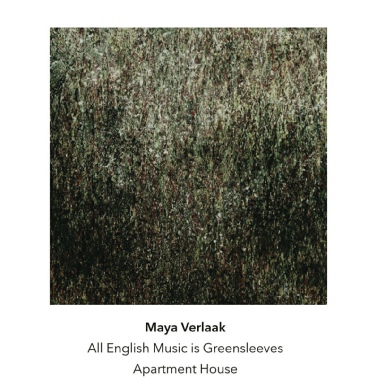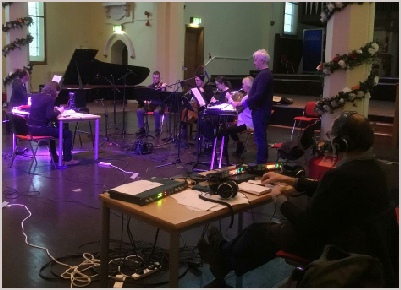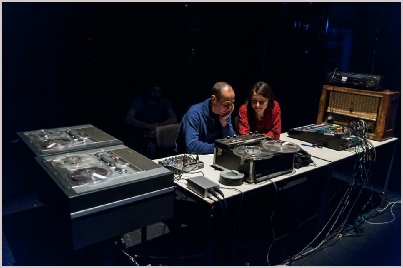Another Timbre TimHarrisonbre
at164 Maya Verlaak - ‘All English Music is Greensleeves’
Five provocative and beautiful works by the young Belgian composer Maya Verlaak, realised by Apartment House and soloists Sarah Saviet & Mark Knoop.
1. ‘Lark’ (2014, rev. 2019) 9:14 youtube extract
Apartment House
2. ‘Formation de Sarah’ (2019) 8:03
Sarah Saviet, violin
3. ‘All English Music is Greensleeves’ (2014, rev. 2019) 10:30 youtube extract
Apartment House
4. ‘Formation de Mark’ (2020) 10:33
Mark Knoop, piano
5. ‘Song and Dance’ (2017) 15:10
Apartment House
CD copies sold out, but downloads are available here

Interview with Maya Verlaak
Can you tell us a bit about your background, and how you came to experimental music?
I’m from Belgium and grew up in the city of Ghent. Even though my parents aren’t musicians, I have always been, as far as I remember, attracted to making music and performing. Schools did not offer music lessons but luckily the evening music schools in Ghent were really good and very well subsidised. When I was 13 years old I was extremely lucky to end up in the class of Marc Maes. Every Thursday evening he was supposed to teach me piano accompaniment, he however noticed my interest in composition and started teaching me composition instead. He had often worked with Karlheinz Stockhausen and was the perfect person to trigger my curiosity in the world of (experimental) contemporary music. When I became 18, Marc suggested that I study at the Royal Conservatoire of The Hague in The Netherlands.
The composition department in The Hague welcomed experimental views and it wasn’t difficult to find like-minded students to create an ensemble with. We supported each other a lot and spent lots of time together experimenting. To name a few of these people: Leo Svirsky, Andy Ingamells, Robert Blatt, David Pocknee, Grzegorz Marciniak, Jeremiah Runnels and Teodora Stepančić. Other composers also travelled to The Hague to work with us, for instance I remember Joseph Kudirka coming in 2011. During these years (2008 - 2012) I developed a very broad view of the possibilities within contemporary music.
The pieces on your CD all involve processes that probably aren’t apparent to the listener, who doesn’t have to know about the processes to enjoy the music. But can you say something about ‘Lark’, first of all. What is it based on, and how does it work?
I’m using the double meaning of ‘Lark’, as in ‘escapade’, but also as the English translation of the French ‘Alouette’. Alouette is a children’s song and I remember having it in a music box and listening to it every evening. I found some old cassettes with recordings of myself as 4-year-old, improvising songs. In 2013 I became curious about these improvised melodies and started to transcribe them. I realised that all the melodies were in some way inspired by the song, Alouette, which makes complete sense as it was one of my only musical reference points at the time.
With ‘Lark’ I tried to search for the lost simplicity and innocence I can hear in my songs on the cassettes. What is it like to create music when your only reference point is just one song? The score of Lark involves performing very simple single notes, however always in reference to the sound of the music box. The music box is both a conductor and a harmonic reference point.
‘All English Music is Greensleeves’ is a striking and provocative title. What does it refer to, and what is going on in the music?
In 2013 I became a student at Birmingham Conservatoire in the UK. My teacher in The Hague, Gilius Van Bergeijk, had warned me that the contemporary music scene in the UK is quite different from what I knew in The Netherlands. He joked that all English composers ever do, is rewrite Greensleeves over again. I had never heard of Greensleeves before so I looked it up and also discussed the joke with my new teachers in Birmingham, Howard Skempton and Michael Wolters. At the same time, I was told about the very good sight-reading practice among UK musicians, and that they would never practice at home because they are so expert at sight-reading. Thinking about this, I started questioning the nature of the musical score in general, and asked myself the question, what if the notes on the score aren’t the pitches musicians should play to hear the music, but the pitches that make them stop playing the music? The “music” is variations on Greensleeves pre-recorded by each instrument in the ensemble. The notes on the musicians’ score parts are pitches that may or may not stop the pre-recorded music that is being played back through tactile speakers on the instruments.
As a result there are two sounding layers, the pre-recorded music (layer 1), which is started or stopped by a computer programme and controlled by the pitches the musicians choose to play (layer 2).
And what about ‘Song and Dance’, which you describe on the score as ‘an excessively elaborate effort to explain or justify’. What does this mean, and how does this piece work?
Composers often talk about their work in order to justify it, and when they do, they analyse it. In this piece, to directly highlight the theme of justification, I developed an idea whereby the ensemble wouldn’t receive any written music from me, but instead they’d receive a written justification for the music. So they receive a musical analysis of the work, rather than a conventionally notated score. I researched the word ‘justification’ and stumbled across the English phrase ‘to make a song and dance about something’, which means ‘an excessively elaborate effort to explain or justify’.‘ Song and dance’ became the title, but also provided me with an idea of some source material: a song or a dance, or a song about a dance.
I carried out an elaborate musical analysis of the chosen source material. The musicians only see this analysis, not the source material itself. So the score consists of text instructions that result in a complex listening game. Most musicians are engaged with listening carefully to each other to establish the melodic and structural part of the analysis. Percussionists I and II perform the rhythmic part of the analysis but also have to react to the resulting melodic material. The pianist performs the harmonic analysis. The game fully relies on the concentration of the performers; in a moment of distraction, the game could get stuck.
But the musicians never know which piece I used as the source material, and a performance doesn’t recreate it; instead, it recomposes it with its own analysis material. Every performance will also be a little bit different.
And finally the two ‘Formation’ pieces, one for violin and one for piano. What is happening here?
Formation de Sarah was the first of these two pieces and is composed for the violinist Sarah Saviet. I travelled to Berlin a couple of times to meet her and discuss ideas. These meetings developed into this set of two new works that try to accentuate the performer’s methods and engagement with musical material.
Sarah reads her score from a computer. But I created a computer application that gives new performance instructions each time in reaction to what she is doing. To perform the piece and establish the desired result, she has to constantly analyse the given material afresh. The score also changes Sarah’s route and gives instructions that don’t fit in with her plan. So what we are listening to is Sarah’s process of dissecting the musical material while she is also trying out different routes through the score in search of the desired result.
Sarah plays together with sine tones and a pre-recorded nail-violin (also played by her). My nail violin is a woodblock with 4 different nails hammered into it and then bowed with a violin bow. Each nail produced two very high-pitched notes. Sarah’s role is to find the correct routes to pair the violin pitches with the nail violin pitches, as if the nail sounds are harmonics of the violin sound. However, the computerised score is constantly pushing her in different directions so that each time she has to find a new route in the hope the computer score reacts in her favour.
The compositional process for Formation de Mark started with recording an untrained singer singing the pitches C, D, E, G, A, B (she sings them as do, re, mi, sol, la, si). She was asked to sing each pitch until it was correct, and then to continue the process with the next pitch. She wasn’t given a starting pitch; her only reference is a computer voice, which in response to her singing, names the actual pitch she is singing. She doesn’t know the theory of musical intervals and so doesn’t have any context. I recorded her process and implanted it into a computer application. In a similar way as in Sarah’s piece, in Formation de Mark Mark Knoop is guided by a computer application and is searching for routes to bring each sung pitch closer to the target pitch.
While composing both pieces, I processed the material of the nail violin and the material of the untrained singer in exactly the same way. The computer score also guides the performers through similar routes. Even though the material is very different, a careful listener can hear similarities in the pieces. Both Sarah and Mark accomplish particular set goals a few times, however other material never finds its resolution. The Formation pieces have no fixed ending; the performer can stop at any moment he or she wishes.
One thing that struck me during the recording sessions is that your pieces rely on an unusual amount of good will from the performers. You are often not giving them what they usually expect to receive (a standard score), and by introducing the game elements, they could easily feel that you are trying to catch them out. It also seemed that when they are having to focus on receiving cues (whether from a computer or from the activities of other musicians), then it’s hard for them to pay as much attention as usual either to the quality of their playing, or to the ensemble sound. So the pieces are challenging and disrupting their expectations in ways that could easily annoy them. Is this something you are conscious of, and are pushing on purpose?
Yes, I’m very conscious of that! I’ve been carefully developing my subversion methods since 2013. This was the first year that I didn’t have an experimental music ensemble anymore. My composer-performer colleagues in The Hague had all gone their own ways and I became interested in implementing the things we had developed together; but how can other musicians who I’m now commissioned to write for, suddenly become equally engaged performers and co-creators?
I always ask myself a lot of questions while composing. Composing is research to me and every piece I make is hopefully a development in my practice. When I think I’m working on ‘automatic pilot’; repeating a particular compositional procedure without thinking, I stop myself and question my compositional process in relation to the context. It is very important to me to share these enquiries; I therefore try to find ways of communicating my journey by making the musicians endure the same unusual journey.
Subversion has destructive connotations. However, subversion can also mean reversing a current standard: being subversive can be anything that challenges an existing system. My approach to subversion doesn’t destroy current standards, but it uses the standards to create, while developing solutions to its own characteristics and problems (with a hint of humour).
A little anecdote: When I was 11 years old, the minister of transport had chosen to cycle with my primary school class through Ghent city centre to show his interest in building good cycle paths for the city. In childish innocence I asked him why he wasn’t simply putting the cars on the small path on the side of the road and giving the big bit of road to the cyclists. ‘NO CYCLE-PATHS BUT CAR-PATHS’ was the newspaper headline the next day. This anecdote gives an example of how to create attention for a certain standard by simply reversing the situation.
Reversing a situation can result in making the performer(s) aware of my enquiries. I give insight into the compositional process in order for them to subsequently gain a complete understanding of the compositional material. This hopefully results in a committed, open-minded performance practice and, as I try to do myself, also encourages the performers to step out of an ‘automatic pilot’ mentality. Some musicians are interested and even relieved to be challenged in such situations; others enter into conversation with me and return the challenge back to me, which I’m happy to take.





